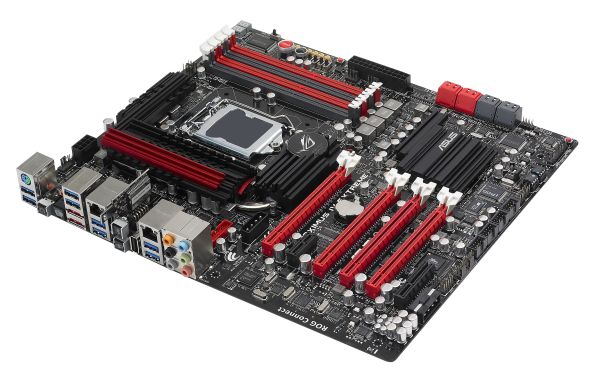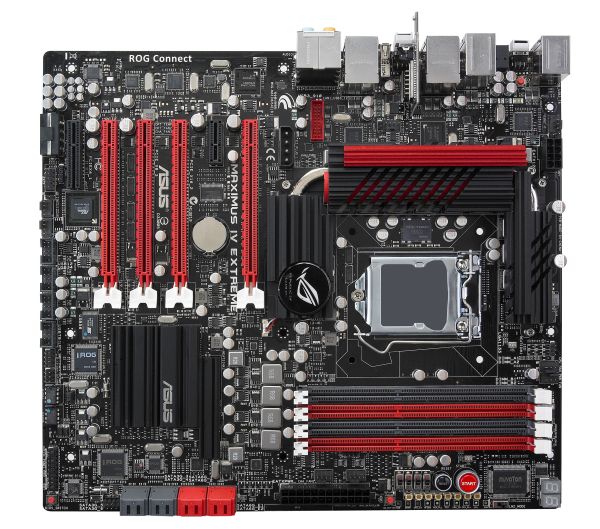A brief look at upcoming ASUS P67 Motherboards
by Ian Cutress on November 14, 2010 1:22 PM EST- Posted in
- News
- Motherboards
- Asus
The first board in the Sandy Bridge series with the Republic of Gamers moniker is the Maximus IV Extreme. This motherboard looks jam-packed with features, and we’d expect nothing less from a ROG product.
The red and black aside, ASUS are attempting to pushing the boat out for overclockers. Of immediate notice is beside the dual-channel DDR3 slots – alongside the power and reset buttons are a set of four switches, designed to enable and disable the PCIe slots as required. Beside these are a set of eight voltage readout points, allowing the monitoring of the various DRAM, NF200, PCH and the CPU voltages across the board. A switch is also present labelled ‘LN2_MODE’, which offers various questions as to what it does, but we suspect at least one of these features is to remove the overcurrent protection when the processor is under liquid nitrogen. One point of humorous mention is that there are three LEDs next to the DDR3 slots, one of them labelled ‘DDR_CRAZY’.
The Maximus IV operates a dual BIOS system, as directed by the two chips labelled BIOS1 and 2, and the BIOS switch in the bottom corner of the board. The dual-digit debugging LEDs, as we would expect, are present also.
Surprisingly, only one 8-pin 12V connector is on the board, which is somewhat odd if the board has a liquid nitrogen mode and power needs to be pumped into the CPU. In terms of extra power for the PCIe slots, a 4-pin molex connector is provided where a PCIe x1 slot is found on the Pro and Deluxe boards. The board is obviously built for multiple graphics card use and overclocking, but as the P67 chipset is designed to only hold 16 PCIe lanes for graphics card usage – ASUS have added an NF200 chip to increase the amount of available lanes, presumably to 32 for an x16/x16 or x16/x8/x8 configuration. On previous motherboard generations, the NF200 chip accounts for a 1-2% loss in performance when the lanes are not fully utilised versus native support, as well as few more extra monies and power usage, thus all the GPU lanes need to be used to get the most out of the board – this is what the consumer is paying for, after all.
The back panel offers the usual myriad of USB 2.0 / 3.0, firewire, eSATA, 5.1 audio, PS/2 and dual Ethernet connectors, but the use of a mini-PCB perpendicular to the motherboard to supply the board with Bluetooth and what looks like a ROG connect switch is interesting. Also of note is an NEC/TOKIN Proadlizer film capacitor, similar to that used on some GPUs, directly next to the socket – presumably to provide more stable power to the socket.
Apart from the possible results this motherboard may or may not achieve, one thing is certain – it will be costing the consumer a pretty penny. No doubt we will have one in to test at some point, and we’ll keep our ears to the ground on other manufacturer’s flagship Sandy Bridge boards.












53 Comments
View All Comments
jonup - Monday, November 15, 2010 - link
Nice catch! I had to look hard to notice it. I almost thought you were on something good. Anyways, I would like to know if the second molex is indead for the PCIx or is it to supply additional power for all the additional controllers on this board. Maybe it is for the NF200.nbjknk - Thursday, November 25, 2010 - link
Dear customers, thank you for your support of our company.Here, there's good news to tell you: The company recently
launched a number of new fashion items! ! Fashionable
and welcome everyone to come buy. If necessary, please
plut:==== http://www.vipshops.org ======
==== http://www.vipshops.org ======
==== http://www.vipshops.org ======
Qapa - Sunday, November 14, 2010 - link
1 - Why would anyone need dual GBe?? Are you expecting to have 2 internet connections with 2 different ISPs, and want to be sure be always online? :P2 - No UEFI? For real? I don't understand that! Specially in high end MBs. And that probably means 2012 till mainstream gets it :(
PS: I also wish something could be done about Intel not having direct support for USB3... any ideas? Cause it is costing us all...
GeorgeH - Sunday, November 14, 2010 - link
1) One reason:http://en.wikipedia.org/wiki/Link_aggregation
2) If it becomes necessary, UEFI can be implemented on top of a BIOS and isn't a complete BIOS replacement anyway:
http://www.uefi.org/about/
3) Intel won't release USB 3.0 until the 2011/12 time frame, which very coincidentally is also the Light Peak time frame. I'll let you connect the dots.
Qapa - Sunday, November 14, 2010 - link
1 - As I said, redundancy seems ridiculous. And more speed the same.2 - Point taken and learnt :) On the other hand, I doubt they will add UEFI to their MBs and how would those really be booting faster as UEFI systems should.
AFAIU, UEFI replaces parts of BIOS, not all. But if they already have full BIOS, would they really remove parts to move them to UEFI? Don't think so.
3 - AFAIK, I think they are even trying to put LightPeak in, ahead of USB3. No dots need connecting here. What I wanted was ideas on what to do to change this and make them put USB3 in the market together with Sandy Bridge...
jonup - Monday, November 15, 2010 - link
3. I don't know. Did you try showing up at Paul Otellini's house with a baseball bat?Dont you get it? Intel has business agenda that does not coincide with your need. Intel vs Qapa -> Intel wins!
strikeback03 - Monday, November 15, 2010 - link
Well since these chipsets are obviously shipping already there isn't anything to be done about USB3 now, the customers simply get screwed. All the SATA ports should have been SATA 6Gb/s and all the USB ports should have been USB3. Maybe these issues will be fixed on more consumer-level versions of the chipset (that can use the integrated graphics in SB), otherwise they are giving AMD another opportunity.Oxford Guy - Tuesday, November 16, 2010 - link
Someone may want to update the Wikipedia page on Link aggregation, if Windows 7 now supports it:"Note that Microsoft Windows does not natively support link aggregation (at least up to Windows Server 2008)."
Regenweald - Sunday, November 14, 2010 - link
Large format printers and plotters often use a dedicated lan port. what if you wanted wired network access on your printing machine as well ? There are many instances where two lan ports can be very handy, as they would in my office right now.Qapa - Sunday, November 14, 2010 - link
Well, that's a niche implementation.More commonly, the printer would be connected to the network as well (router/switch/etc), so everyone can access it and not only your computer.
Still, seems overkill to me.